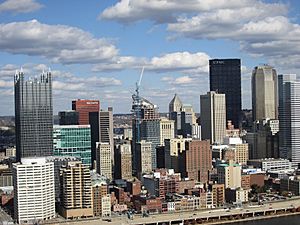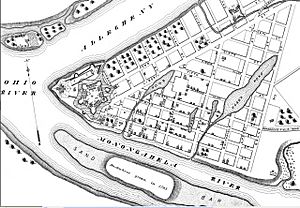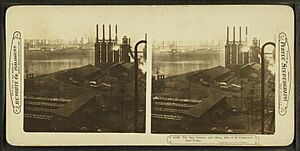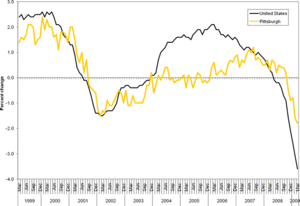Economy of Pittsburgh facts for kids
The economy of Pittsburgh, Pennsylvania is very diverse. It focuses on services, medicine, higher education, tourism, banking, and high technology. Pittsburgh was once famous for its steel industry. It is still known as "The Steel City". However, today there are no large steel mills inside the city itself. Some Pittsburgh-based companies like US Steel still own mills nearby.
Pittsburgh was chosen for the 2009 G-20 summit because its economy has changed so much. It is a great example of a modern 21st-century economy. In 2009, President Barack Obama said Pittsburgh shows how to create new jobs. It also shows how to build new industries.
Forbes magazine listed Pittsburgh as a top city for job growth in 2009. This was due to its strong healthcare and education industries. It also has good foundations in technology, robotics, and banking. Pittsburgh was ranked as the 169th best city for job growth overall.
Pittsburgh has also been named one of the top five most livable cities many times. This was in the Places Rated Almanac rankings.
Contents
Pittsburgh's Economic Story
Early Beginnings
In the mid-1700s, Pittsburgh's economy was mostly about farming and trading. After the American Revolutionary War, the government added a tax on whiskey. This was to help pay off national debt. In 1794, the Whiskey Rebellion happened in Pittsburgh. Farmers protested the tax because they often traded goods instead of using cash. President Washington had to send troops to enforce the tax laws.
Around the same time, large amounts of coal were found near Pittsburgh. Mount Washington, once called "Coal Hill," had very valuable coal. Pittsburgh's location was also key. It sits where the Monongahela, Ohio, and Allegheny Rivers meet. This made it a major trade spot. It helped Pittsburgh become a leading industrial center.
The first big industry in the 1800s was boat building. They built flatboats for pioneers and goods. They also built keelboats that could travel upstream. The second largest industry was glass production. The first glass factory opened in 1795.
The 1800s: Rise of Industry
Many of Pittsburgh's richest business leaders in the 1800s lived in East Liberty. These included H. J. Heinz, George Westinghouse, Andrew Carnegie, and Henry Clay Frick. They all believed in capitalism. They used their skills to earn very high incomes. Pittsburgh became known for having some of the world's wealthiest people.
Andrew Carnegie was also known for his charity. He believed that wealth should be used to help the community. In 1889, he wrote "The Gospel of Wealth". He said that extra personal wealth should be used for public good. The Carnegie Library, which is free, opened in Pittsburgh in 1890. Carnegie gave over $350 million to public organizations.
Important groups like the Duquesne Club (1873) and the Greater Pittsburgh Chamber of Commerce (1874) were founded. The Pittsburgh Stock Exchange also started in 1864. It first traded oil and coal, then all stocks by 1894. It closed in 1974 as trading became more computerized.
Railroad networks reached Pittsburgh in the mid-1800s. The Ohio and Pennsylvania Railroad opened in 1851. The Pennsylvania Railroad reached Downtown Pittsburgh by 1852. Andrew Carnegie quickly used the railways. In 1865, he started the Pittsburgh Locomotive and Car Works. This company was a leader in its field.
In 1892, Pittsburgh faced the Homestead Strike. This was a violent conflict between steelworkers and the Carnegie Steel Company. The company won, which stopped unions from forming in Pittsburgh for a while.
The Age of "Big Steel"
After Carnegie Steel became U.S. Steel in 1901, it and J&L Steel ruled the local economy. Many other companies also helped the steel industry. These included Cyclops Steel, Mesta Machinery, and Dravo Corporation. Other big names were National Steel Corporation and Allegheny Technologies.
Pittsburgh produced about one-third of the nation's steel by the 1920s. It was home to the world's largest tube mill, structural steel plant, and rail mill. The city also had the biggest wire manufacturing plant and bridge building plant. Pittsburgh had a lot of coal, which was key for making iron and steel. About 40% of the nation's coal came from near Pittsburgh.
The Union Railroad, started by Carnegie in 1894, still serves steel mills today.
The 1900s: Steel's Peak and Decline
In the early 1900s, Pittsburgh's economy was mostly about steel. The city's population grew a lot, reaching 321,616. At one point, Pittsburgh was the eighth-largest city in America. In 1901, steelworkers went on a big strike against U.S. Steel.
By the 1950s, business and government leaders worked together. They wanted to keep local industries strong. Groups like the RIDC were formed to help with this goal.
However, in the early to mid-1980s, the steel industry collapsed. This left half of the nation's steelworkers without jobs. The number of steelworkers in Pittsburgh dropped sharply. It went from 90,000 in 1980 to 44,000 in just four years.
Pittsburgh was also a major center for advertising and public relations firms. Retail chains like G. C. Murphy and Giant Eagle started here.
Shifting to a New Economy
Between 1970 and 1990, Pittsburgh's main jobs changed. In 1970, one out of three jobs was in manufacturing. By 1980, this dropped to one in four. The city began to move away from heavy industry.
Allegheny County became a center for healthcare and higher education jobs. These areas created many high-paying jobs between 1999 and 2005. Education jobs made up almost 80% of these in Allegheny County. Pittsburgh also saw growth in professional services, finance, and wholesale trade.
The tourism industry has also grown a lot. Big events in Pittsburgh have created over 11,000 new jobs. About 6,000 of these are within Allegheny County. Pittsburgh has always been an important center for finance and banking.
Pittsburgh Today
Since 2009, Pittsburgh has hosted the yearly DUG East Conference.
Here are the top private employers in Pittsburgh:
| Rank | Employer | Number of Pittsburgh employees | Product(s) |
|---|---|---|---|
| 1 | University of Pittsburgh Medical Center | 40,600 | Health care |
| 2 | University of Pittsburgh | 12,600 | Higher education |
| 3 | PNC Financial Services | 9,200 | Financial services |
| 4 | Allegheny Health Network | 8,900 | Health care |
| 5 | Giant Eagle | 8,000 | Supermarkets |
| 6 | Bank of New York Mellon | 7,610 | Financial services |
| 7 | Highmark | 5,270 | Health insurance |
| 8 | U.S. Steel | 4,700 | Steel manufacturing |
| 9 | Carnegie Mellon University | 4,600 | Higher education |
| 10 | Verizon Communications | 3,750 | Telecommunications |
Pittsburgh was not hit as hard by the 2008 economic recession as many other cities. This is because it had already shifted away from heavy industry. Its economy now relies on health services, education, and new technologies. Housing prices in Pittsburgh even rose during this time.
Technology and Innovation
Pittsburgh has become a major technology hub. Companies like Google, Apple Inc., Intel, Uber, and Facebook have offices here. The Pittsburgh Technology Center and Pittsburgh Supercomputing Center also work on big innovations.
Companies like Duolingo and others have their main offices in the city.
The 2009 G-20 Summit
Pittsburgh was chosen to host the 2009 G-20 summit for good reasons. The city uses its past strengths in manufacturing and business services. It also focuses on green energy. Pittsburgh's factories employ almost 100,000 workers. The region is a big market for the metals industry.
Pittsburgh is also home to large business and financial services. These contribute a lot to the local economy. The city has a history of energy innovation, from oil and coal to natural gas. Now, it focuses on sustainable and efficient energy. Pittsburgh has over 30 LEED certified buildings. This means they are designed to be environmentally friendly.
Planning for the Future
Pennsylvania requires every county to have a land use plan. "Allegheny Places" is the plan for Pittsburgh and Allegheny County. It was approved in 2008. This plan is a guide for a sustainable future for the county.
The plan aims for a future where:
- Everyone has fair access to economic opportunities.
- Old industrial sites are cleaned up and redeveloped.
- Public transport helps reduce traffic. It connects key economic areas like Oakland and Downtown.
- Green spaces like parks and trails link communities.
- There is good, affordable housing for everyone.
- The economy is diverse, offering stable, well-paying jobs.
The plan includes special "enterprise zones." These are areas in the city with fewer taxes and rules. Studies show these zones can help create jobs and attract investment. The plan also supports research and technology growth. Local universities and medical centers help with this. They provide the right environment for new industries.
Moving Up Economically
A 2014 report said Pittsburgh is the second-best American city for economic mobility. This means it's a great city for people to improve their financial situation. It's a good place to achieve the American Dream.
Recent News
In early 2013, major property managers in Pittsburgh included CBRE Group and Oxford Development.
On August 13, 2013, the Pittsburgh Post-Gazette reported that the H. J. Heinz Company would lay off 350 office workers in Pittsburgh. After this, the company still had about 800 employees in the area.
Work began in 2014 on a plan for innovation in the city.
![]() This article incorporates public domain material from the United States Government document "Occupational Employment and Wages in Philadelphia and Pittsburgh, May 2007".
This article incorporates public domain material from the United States Government document "Occupational Employment and Wages in Philadelphia and Pittsburgh, May 2007".





